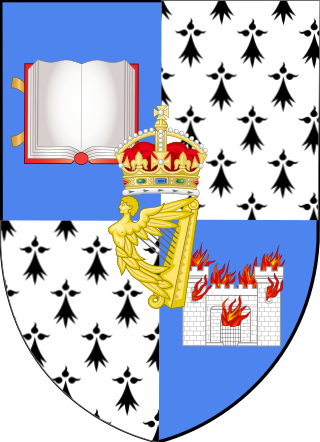
The University of Dublin, corporately designated the Chancellor, Doctors and Masters of the University of Dublin, is a university located in Dublin, Ireland. It is the degree-awarding body for Trinity College Dublin. It was founded in 1592 when Queen Elizabeth I issued a charter for Trinity College as "the mother of a university", thereby making it Ireland's oldest operating university. It was modelled after the collegiate universities of Oxford and of Cambridge, but unlike these other ancient universities, only one college was established; as such, the designations "Trinity College" and "University of Dublin" are usually synonymous for practical purposes.

Keith Williams is a British architect and founder of London-based Keith Williams Architects.

The American Institute of Architects (AIA) is a professional organization for architects in the United States. It is headquartered in Washington, D.C. AIA offers education, government advocacy, community redevelopment, and public outreach programs, and collaborates with other stakeholders in the design and construction industries.

The Institution of Engineers of Ireland or the IEI, is the second oldest Engineering Society on the islands of Great Britain and Ireland, and was established in 1835. The institution primarily represents members based in Ireland.

Terry Leyden is an Irish former Fianna Fáil politician who served as a Senator from September 2002 to March 2020, and previously during December 1992. He served as a Teachta Dála (TD) from 1977 to 1992, and as a Minister of State from March to December 1982, and from 1987 to 1992.
The architectural technologist, also known as a building technologist, provides technical building design services and is trained in architectural technology, building technical design and construction.

A building engineer is recognised as being expert in the use of technology for the design, construction, assessment and maintenance of the built environment. Commercial Building Engineers are concerned with the planning, design, construction, operation, renovation, and maintenance of buildings, as well as with their impacts on the surrounding environment.
Scott Tallon Walker is an architecture practice with its head office in Dublin, Ireland and further offices in London, Galway and Cork. It is one of the largest architecture practices in Ireland. Established in 1931 as Scott and Good, becoming Michael Scott Architect in 1938, and Michael Scott and Partners in 1957 before changing to the current Scott Tallon Walker in 1975. Scott Tallon Walker and its earlier incarnations developed a reputation for modernism.
A chartered professional is a person who has gained a specific level of skill or competence in a particular field of work, which has been recognised by the award of a formal credential by a relevant professional organization. Chartered status is considered a mark of professional competency, and is awarded mainly by chartered professional bodies and learned societies. Common in Britain, it is also used in Ireland, the United States and the Commonwealth, and has been adopted by organizations around the world.
Professional requirements for architects vary from place to place, but usually consist of three elements: a university degree or advanced education, a period of internship or training in an office, and examination for registration with a jurisdiction.
In Ireland, the term city has somewhat differing meanings in Northern Ireland and the Republic of Ireland.

Phoenix Heights, also known as 4 Mastmaker Road, is a mixed tenure residential development in the Millwall area of London, near to South Quay DLR station and Canary Wharf. It forms a social housing commitment developed as part of the nearby Pan Peninsula project.

The Architects' Alliance of Ireland (AAoI) (Irish: Ailtirí 'Comhaontas na hÉireann) is an Irish pressure group founded in 2009. Its purpose is to lobby for a change in recent legislation in Ireland.
Irish law allows firearm possession on may-issue basis. With approximately seven civilian firearms per 100 people, Ireland is the 107th most armed country in the world.
The Institute of Designers in Ireland (IDI) was formed in 1972 and is the professional body representing designers and design students from different disciplines who practice on the island of Ireland and abroad. The IDI is one of Ireland’s largest and oldest association of design professionals. The Institute is a membership-based not-for-profit organization.
Deirdre O'Connor FRIAI was an Irish architect. She was the first female president of the Architectural Association of Ireland.
Thomas Joseph Byrne was an English architect, and was principal architect to the Office of Public Works in Ireland who oversaw the restoration of a large number of public buildings in Dublin following the Easter Rising, the Irish War of Independence and the Irish Civil War.
Valerie MulvinFRIAI is an Irish architect. She is a member of Aosdána, an elite Irish association of artists.

Tomás "Tom" de PaorFRIAI Int FRIBA is an Irish architect and member of Aosdána.








